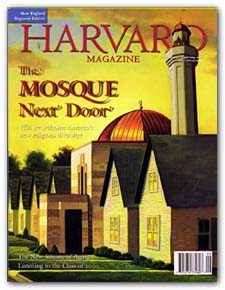
Main Menu ·
Search · Current Issue · Contact · Archives · Centennial · Letters to the Editor · FAQs

Please note that, where applicable, links have been provided to original texts which these letters address. Also, your thoughts may be sent via the online Letters to the Editor section.
How Will We Cope with Religious Diversity?
 Professor Diana Eck's "Neighboring Faiths" (September-October,
page 38) is timely and thoughtful. It will play an important role in the
acceptance of Muslims within mainstream America.
Professor Diana Eck's "Neighboring Faiths" (September-October,
page 38) is timely and thoughtful. It will play an important role in the
acceptance of Muslims within mainstream America.
Eck raises an interesting issue on how Islam will adapt to the modern world,
a "reformation" that is long overdue. Muslim clerics, who are
caught in a time warp, recognize that they can maintain their privileges
only by suppressing dissent and dialogue; in this task they have been ably
assisted by the Western media, which has demonized the religion and its
adherents. The impetus for reform may well come from scholars trained and
teaching in the west, Eck's "students."
Akbar Husain, M.B.A. '70
Nairobi
Eck's scholarship is a commendable effort to describe an overwhelming problem,
complete, alas, with a traditional scholarly reluctance to come to grips
with it. I leave her account beset by a fear for the erosive results current
levels of diversity, religious and other, are bringing to the unity of our
country.
Our E pluribus unum motto is one of the more fortunate descriptives bequeathed
us by the Founding Fathers. In my youth, I believed that I and my fellows
understood it fully. It meant that diversities in our citizenry-differences
in language, clothing, history, and, yes, religion, would be subsumed into
the unity of one people.
Differences were not meant to be eradicated, but they and we would become
parts of a greater whole. Importantly, the continuance of cultural diversities
in ourselves would be protected-sheltered- by not being thrust upon the
public scene, but yet preserved by law and tradition for our individual,
private use.
But there are now abroad in our land religions of a differnt kind, in that
they intrude their rules and practices, and worship, into the public domain.
They are not exclusively private; they are starkly visible, intrusively
visible.
Eck writes that the leaders of the various religious institutions are also
the leaders in the efforts to accept one another. But the leaders have vested
interests that the congregations do not. The key to the success of pluralism
is how the members of the diverse religious groups, not their leaders, embrace
one another. Current scorecards are not encouraging.
Jack Harney '46
New Carrollton, Md.
Eck refrains from examining an important issue: the role of women in these
Eastern traditions, and how this role clashes with the traditional American
(and Western) concepts of self-worth and self-determination for women.
I think about what I see when I shop at a discount-club warehouse store
in suburban Washington, D.C. There, men in Western dress stride up and down
the aisles, followed by veiled women in full-length, long-sleeved gowns.
The women always walk behind their husbands, push the shopping cart, and
generally have several children in tow. The women are never seen alone-they
don't drive. What will happen when someday their little girls want a driver's
license and the chance to go to college? Will their parents let them, or
will they be kept in "their place?"
These traditions will either have to accommodate, in some way, the American-Western
idea of the role of women, or become Amish-like and withdraw from the mainstream
of American life.
Joanne Sadler, M.P.A. '91
Alexandria, Va.
Thanks for this magazine and for putting it on the Web. I heard of Eck's
article on pluralism but could not locate the magazine in my area. Thought
of the Web, and you were there. As a chaplain in the United States Army,
I've experienced lots of diversity. A nice piece of literature.
Rick Lund
Fort Hood, Tex.
 Freedom of Expression
Freedom of Expression
The September-October issue is delightful, as always, but I do have a small
bone to pick. In "Visions of Veritas" (page 71), you reproduce
eight clay tiles representing eight artists' interpretations of the Harvard
shield. Harvard's motto is Veritas. Imagine my surprise to see one of the
tiles proclaim Veritas Vos Liberabit, on a crimson field. That is the
motto of Johns Hopkins University. What happened?
Edward S. Bessman, M.D. '81, Hopkins '77
Millersville, Md.
Editor's note: "The truth shall set you free" is indeed the
motto of Johns Hopkins. That university's academic colors are old gold and
sable. Artist Kathi Tighe, a staff member at the Radcliffe Ceramic Studio, set
out to make a tile that said "veritoes," but came to think her
tile needed hands as well, and so she simply chose a motto that pleased
her and that employs the word veritas. She was aware of its Hopkins connections.
She is a graduate of Ohio Wesleyan.
Erotic Horseplay
Your magazine has shown a genuine and unrivaled absence of editorial sense
before, but "Erotic Horseplay" (September-October, page 24) takes
the cake. I can explain a decision to report on such an asinine subject
only as some sort of practical joke.
To Deborah Bright, the Bunting Institute fellow behind this fraud, I give
my congratulations on devising an artful and clever scam. I sincerely hope
the Bunting, whose doors I passed many times in utter ignorance of what
went on behind them, feels they got their money's worth in Bright's "work."
T.C. Gillespie, A.M. '84
Monterey, Calif.
While I enjoyed Bright's observations about the erotic appeal of horses,
I couldn't help feeling the irony surrounding her description of that appeal.
She laments that "Puritanism is alive and well, particularly for those
in charge of youthful girls," so that to admit an erotic relationship
between horse and rider is to "upend the order of things." But
she herself then chooses an explicitly moralistic concept-that of "fetishism"-
by way of normalizing the relationship.
In both Marx and Freud, fetishism concerns the continual misunderstanding
of an object's value, use, or history. Bright admits that those who like
horses understand their value quite well. Why insist, then, on calling this
"fetishism," if what Bright wants to discuss would be more accurately
described in terms of a readily understood and (as she suggests) normal
pleasure?
Douglas Bruster, Ph.D. '90
Austin
Risky Business
John Graham, of the Harvard Center for Risk Analysis, whose work is reported
on in "Life, Death, & the Dice" (September-October, page 19),
seems to share the snobbery of many other professional risk assessors toward
the fears of ordinary people. The professionals tend to do their risk-benefit
calculations on a global scale and tend to brand as ignoramuses those who
do them on a personal scale. Thus, an automobile may be more dangerous than
a nuclear power plant for society at large. But the person who owns a car
has done his or her personal risk-benefit calculation and decided that
the risk is "personally" worth it. But that same person gets no
benefit whatever from living next door to a nuke-indeed, Illinois,
one of the most highly nuclearized states in the country, also has some
of its highest electric utility rates. Why should our hypothetical person
be willing to accept "any" risk, however small, for the benefit
of Commonwealth Edison stockholders?
Marian Henriquez Neudel '63
Chicago
 |
The right bucket. Photograph by Kris Snibbe
|
Wrong Bucket
What a beautiful photograph of the killer bucket illustrating "Life,
Death, & the Dice." The lighting, the colors; sinister yet gorgeous.
Too bad it's the wrong picture. What I at first thought was a silly
mistake is really journalistic negligence because you threw away a half-page
chance to alert your readers to the real killer bucket. It is the five-gallon
cylindrical kind that institutional supplies typically come packaged in.
Toddlers fall in head-first and can't get out, partly because the bucket
does not tip over easily. As a mother I call shame down upon your rock-filled
head. Do bestir yourself to find and print a photo of the right bucket.
Holly Czapski, M.P.M. '92
Somerville, Mass.
See additional letters.
Main Menu ·
Search · Current Issue · Contact · Archives · Centennial · Letters to the Editor · FAQs

![]()

 Professor Diana Eck's "Neighboring Faiths" (September-October,
page 38) is timely and thoughtful. It will play an important role in the
acceptance of Muslims within mainstream America.
Professor Diana Eck's "Neighboring Faiths" (September-October,
page 38) is timely and thoughtful. It will play an important role in the
acceptance of Muslims within mainstream America. Freedom of Expression
Freedom of Expression
![]()